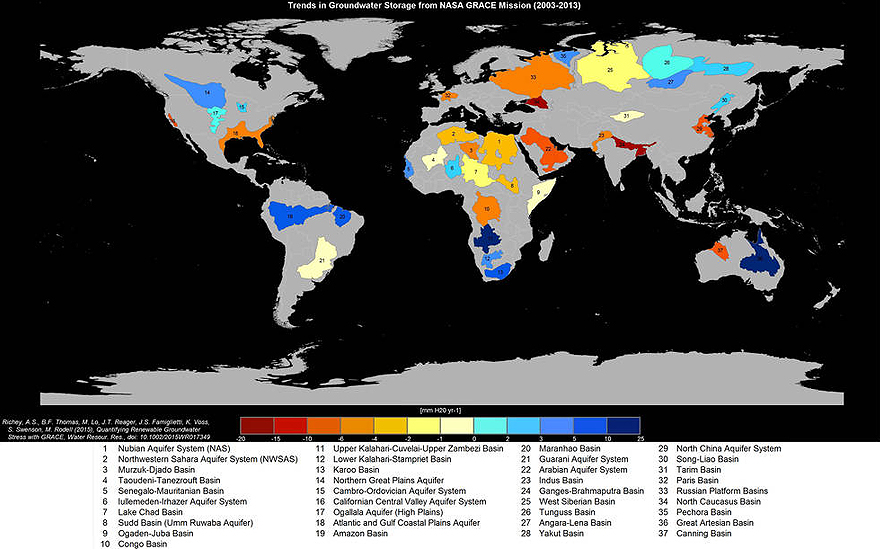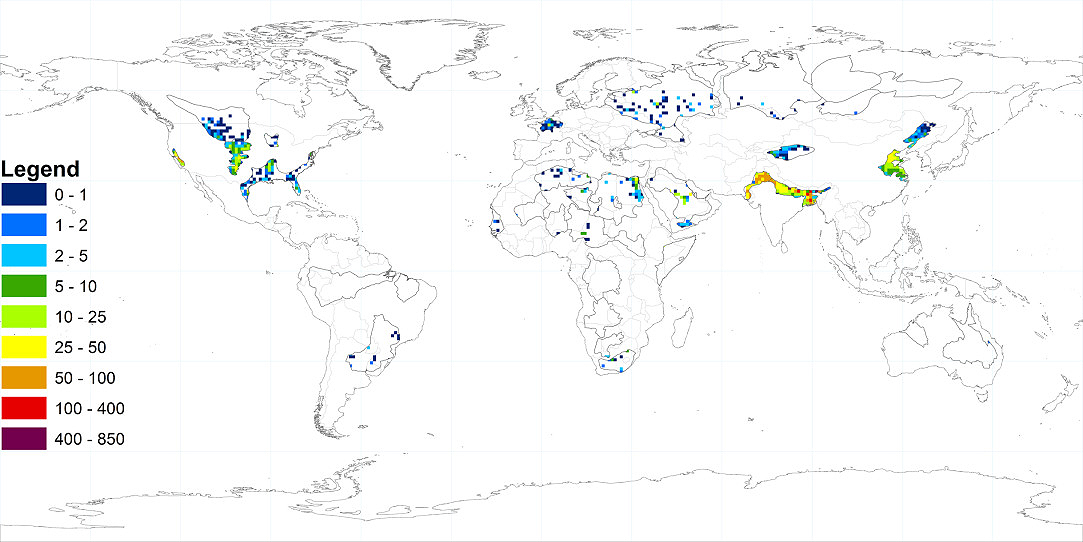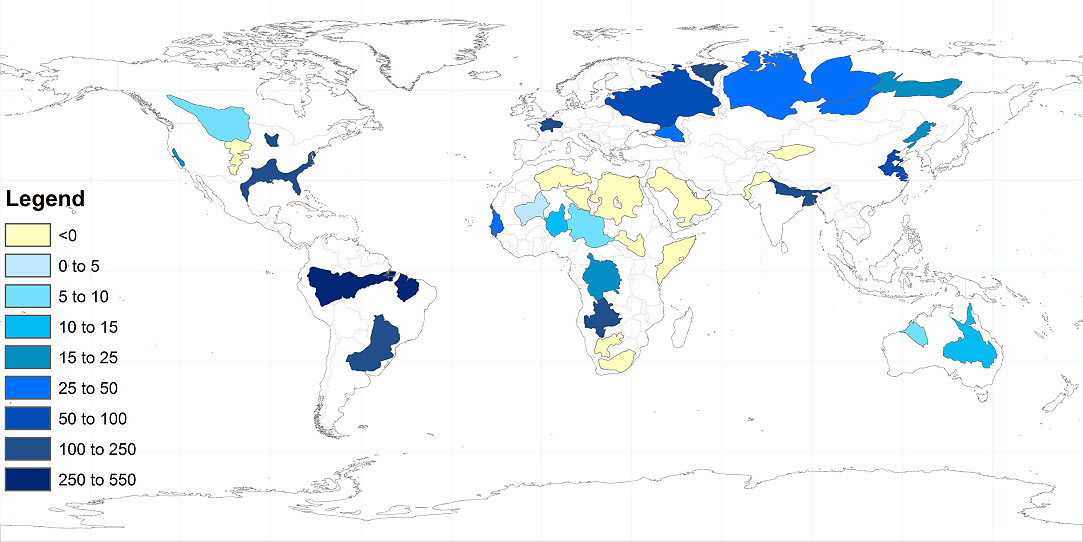Geopolitical misgivings about perceived foreign interests should not distract beneficiary countries from implementing sustainable use.
The Guarani Aquifer has given rise to a more political than scientific literature in South America, denouncing the alleged interest of great powers (formerly the United States, now China) to take away the water that naturally belongs to the countries of the region. These crusades often distract from a more indisputable fact: the risk comes not so much from outside as from uncontrolled practices and the lack of clear legislation in the aquifer countries themselves. This article reviews the results of some recent programs of study on the characteristics and status of the Guarani Aquifer.

▲ source: UC Irvine/NASA/JPL-Caltech
article / Albert Vidal
About one third of the large groundwater aquifers are at a critical status . Current technology does not allow us to accurately predict how much water we have left on the planet, and precisely because of this uncertainty, accelerated groundwater extraction is too great a risk not worth taking.
The map above shows the 37 largest aquifers in the world, which have been studied by a NASA satellitemission statement known as the Gravity Recovery and Climate Experiment (GRACE). This mission statement has attempted to measure the water levels in the aquifers, in order to check the water stress to which they are subjected, as well as their level of renewal. Of these, there are 21 whose extraction is not sustainable, and they are losing water very rapidly. Among these, there are 13 whose status is particularly critical (darkest red), and threatens regional water security. There are 16 other aquifers that enjoy sufficient recharge to not lose water or even gain water; these are marked in blue.
This NASA research , the results of which are analyzed in a study by Water Resources Research, divides aquifer water stress into 4 different types, from highest to lowest intensity: extreme stress, variable stress, human-dominated variable stress, and no stress. Let us now look at another map, collected in that study, which shows sample the spatial distribution of groundwater abstraction in the world:
|

source: Water Resouces Research
|
The color of the dots indicates the intensity of extraction, measured in millimeters per year. Thus, this statistic sample is the sum of withdrawals for industrial, agricultural and domestic use. At first glance, it can be seen that the countries that suffer the most accelerated extraction are India, Pakistan, China, Egypt and the United States. In the case of the Guarani Aquifer, the extraction points are located in Paraguayan territory and near Sao Paulo, with an extraction of between 0 and 5 millimeters per year.
The research has produced other maps that may be useful to financial aid for a deeper understanding of the problem. In this case, the following map sample shows an average of the annual recharge of aquifers in the world.
|

source: Water Resouces Research
|
The yellow color represents negative recharge, i.e., systems that are losing water. The blue color, on the other hand, marks those aquifers that have a positive recharge (the more intense the blue color, the greater the recharge). The Guaraní aquifer, in particular, has a recharge of 225 millimeters per year.
Finally, we will see two maps referring to the water stress of aquifers.
|

source: Water Resouces Research
|
The countries listed above (a) suffer from extreme water stress, i.e., natural recharge is negative, and there is also intense human use. This particularly affects the African continent, the United States, the Middle East and the heart of Asia.
Here we show (b) those aquifers with a variable stress level. This means that they have a positive natural recharge, but at the same time there is a human use that could be detrimental. The Guarani Aquifer is included in the latter group.
The Guarani Aquifer
Making reference letter to a famous phrase from one of Franklin D. Roosevelt's speech - "with great power comes great responsibility"- we can say that the countries that enjoy access to the Guarani Aquifer System (GAS), must assume the responsibility that comes with having been endowed with this important natural resource . They know that, many times, such riches bring competition, unrest and even problems such as internal instability and tensions between some large companies and governments.
The SAG is a transboundary aquifer that extends below the surface across 1.2 million km2 between Brazil, Uruguay, Paraguay and Argentina. According to the most recent research, this is the third largest groundwater reservation in the world in terms of surface area, and contains about 45,000 km3. The low recharge capacity is the most common problem in the aquifers of our planet, since it is usually not enough to cover the amount extracted, thus jeopardizing their sustainable use. This system is particularly important because of its very high renewal capacity (between 160 and 250 km3 per year), which takes place thanks to the abundant rainfall that feeds it.
Challenges posed by
Let us begin, then, with a brief historical contextualization. There have been several moments that will help us understand the current state of interests and challenges surrounding the SAG. In 1969 the La Plata Basin Treaty was signed, to carry out a series of programs of study on the hydrological basin of La Plata (which includes the Guarani Aquifer). Three decades later, in 2001, the agreement framework on the Environment of Mercosur was ratified, which highlighted the importance of the environment and proposed the creation of a legal framework to conserve it. Between 2003 and 2009, the project for the Environmental Protection and Sustainable development of the Guarani Aquifer System(PSAG) was developed thanks to the impulse of the four countries of the Rio de la Plata Basin, to prepare a framework of management of the SAG with environmental sustainability criteria (and to anticipate future problems). Finally, in 2010, the Treaty of San Juan was signed; a much broader treaty of cooperation, but one that was not ratified by all state parties. Also known as agreement of the Guarani Aquifer, it was influenced by many supranational bodies and transnational companies. So, the question arises, where are the problems?
|

sourceOwn elaboration based on several programs of study
|
Well, first of all, Argentina and Uruguay ratified the agreement of the Guarani Aquifer in 2012, which provided for a series of restrictions on water extraction, in order to manage the aquifer's resources in a more sustainable way. What happened is that neither Brazil nor Paraguay ratified it at that time and, their signatures are necessary for the agreement to enter into force. Surprisingly, Paraguay stepped forward in 2018 and ratified the agreement, showing signs of wanting more cooperation. Brazil depends heavily on the water extracted from the SAG (especially its southern provinces), so it wants to renegotiate the agreement of the Guarani Aquifer, to obtain more favorable conditions.
Of course, Brazil is not the only one that has problems with the current status . Paraguay, for example, did not ratify the agreement until 2018, alleging a violation of national sovereignty (something totally understandable, if we take into account that Paraguay owns the area aquifer recharge with the largest extension). As an example of all this, Miguel Giraut, from the Ministry of Mines and Energy of Argentina, commented in 2016 that coordination was non-existent.
In addition to these regional tensions, there are other subject problems related to interference from outside powers, international organizations and transnational corporations. Again, a reservation such as the SAG is especially attractive to companies and some countries that need to secure their supply of water resources. However, these dangers are relatively innocuous compared to others that could lead to aquifer contamination or irreversible change in the ecosystem.
If we face this question with some realism, it is unlikely that there will be intentional contamination of the aquifer (by chemical attack, for example), as this would benefit no one. Certainly, there is the danger of accidental contamination by the discharge of toxic substances from agriculture. In Brazil, specifically, there is a lot of agribusiness being developed over the aquifer (especially for soybean cultivation). It happens that, through the same cracks through which the water that recharges the aquifer passes, pesticides, residues and agrotoxins can also enter. In addition, the recent introduction of hydraulic fracturing techniques (known as fracking) is another potential source of contamination.
Another possible risk comes from an accelerated extraction by transnational companies or governments themselves, which would exceed the level of recharge and produce irreversible changes in the ecosystem. Deforestation brings another risk factor: water infiltration capacity is lower when trees are cut down, and the soil is exposed to erosion and pollutants as it loses nutrients (especially in recharge areas). In addition, population pressure and economic growth add even more variables to the uncertain future.
Uncertain but hopeful future
In summary, although these challenges may evolve negatively, there are many reasons that give us hope. After all, the aquifer water is highly valued for its medicinal purposes, its usefulness for the coffee industry and its use in geothermal energy production. That is why the owners of this precious resource are the first ones interested in conserving and managing it in a sustainable way, and they are fully aware that cooperation is crucial.
Moreover, the SAG could increase the geopolitical and geoeconomic importance of the region, which until now has been considered a peripheral region on the international scene. It is obvious that water is gaining importance as a natural resource given its scarcity and growing demand. Although it is unlikely that the region will become a major player, due to its geographical location and integration difficulties, it could give rise to the four Southern Cone countries taking leadership positions in areas related to sustainable extraction and fair distribution of water in the future. To seize this opportunity, it is necessary to adopt exemplary attitudes right now. If this happens, not only will they be considered exemplary countries, but they will surely attract investment in new and more efficient extraction methods. All this, in addition, will enhance the socio-economic development of the population living above the aquifer, which, if it can be maintained, will mark the future of South America.